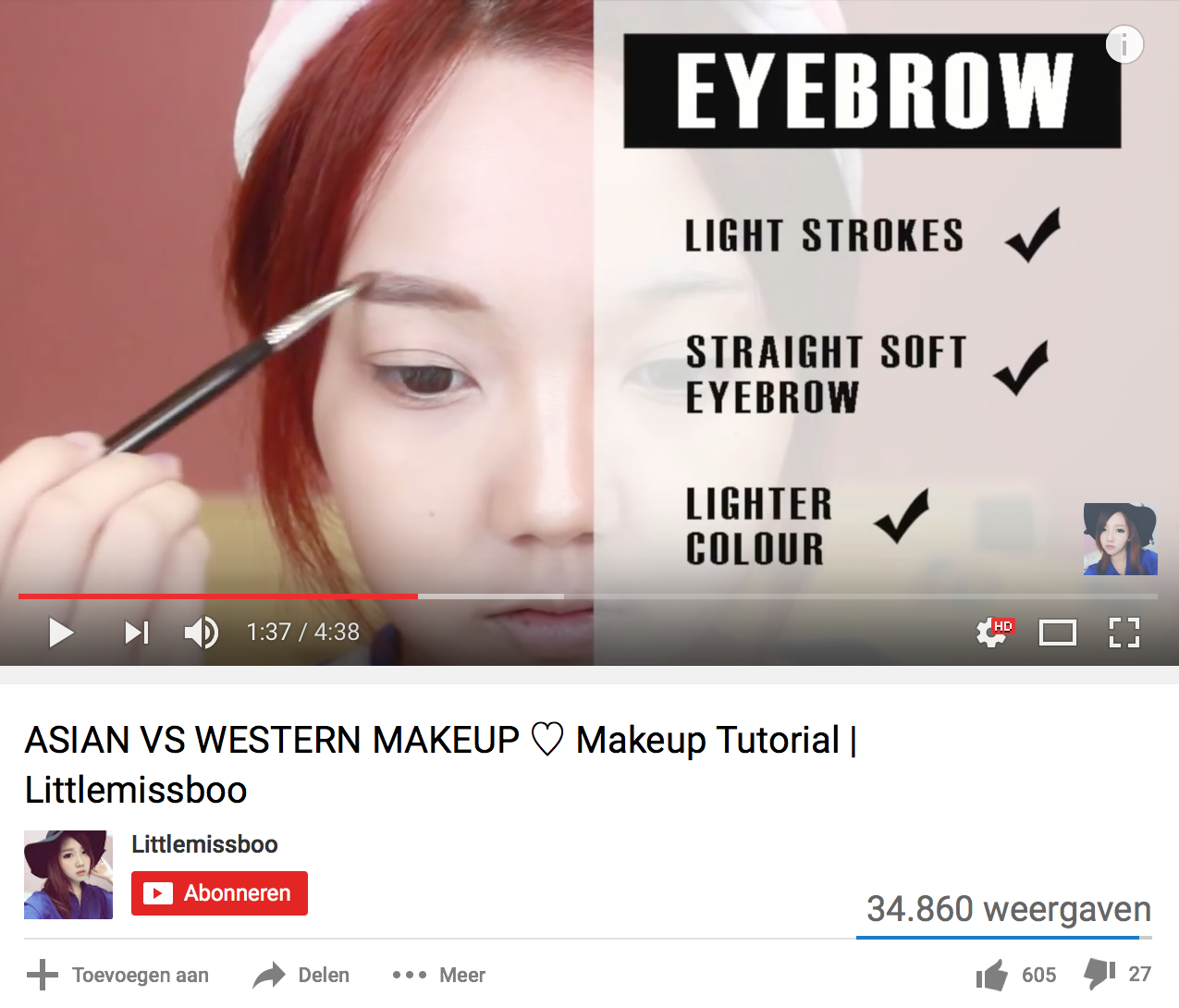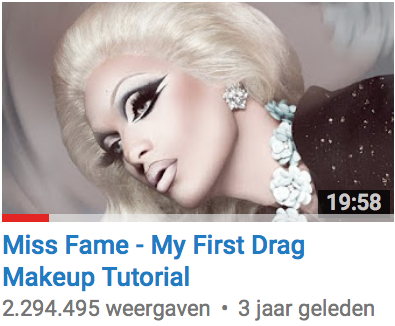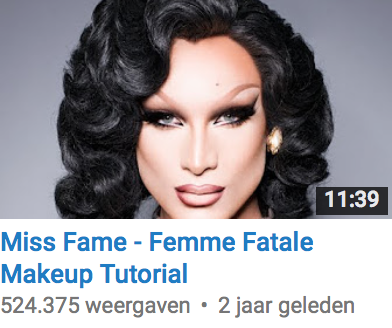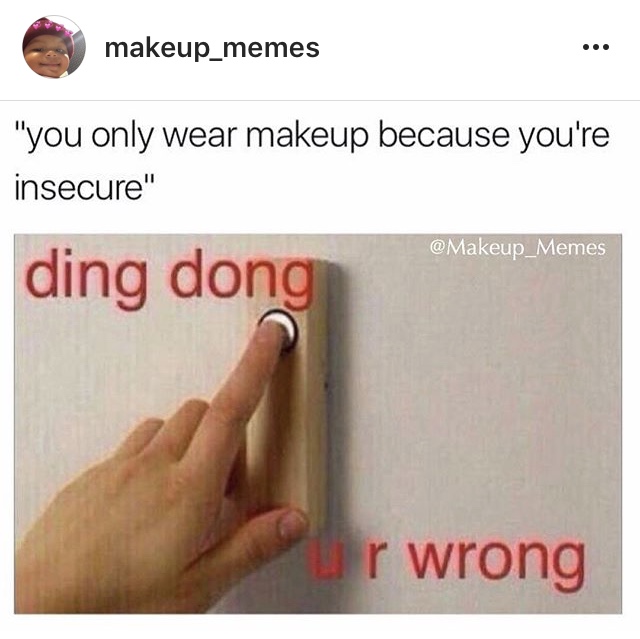
Make-up lovers in the online world
The creation of a micro-population.
In this paper, the behavior and norms within the micro-population of make-up lovers will be analyzed.
Women have been applying make-up since ancient times and many trends have passed by. Nowadays, interest in make-up has come to a new level: women and men from all over the world share a passion for make-up. The internet, esspecically digital media platforms like Instagram and YouTube, has given them an infrastructure on which they share their passion for this consumer product. We can now say that this group of make-up lovers can be seen as a global micro-population.
Micro-population is a concept introduced by Maly and Varis (2015) and they argue that “the world has become more complex due to new kinds of migration patterns and mobilities, the influence of new communication technologies such as the Internet, as well as the neoliberal logic of consumption and commodification. Culture, as a result, is a complex translocal and polycentric affair”. The make-up lover is a perfect example of this: this micro-population is translocal, polycentric and multi-layered.
In this paper, I will focus on concepts like polycentricity, multi-layeredness, ‘how to’ discourse, micro-celebrity, novice, master, and norms. Iwill apply these concepts to this micro-population. In the end, I will sketch a picture of what it is like being a part of this micro-population: what does one need to know in order to become a master? Which norms are being conveyed? What does it mean to be a make-up lover?
Digital ethnography
Communication among make-up lovers happens via digital infrastructures. In order to understand how this group functions, I have conducted digital ethnographic research. When doing this type of research, one analyses the behaviour of members of a social group on digital platforms. Digital ethnographic research can be defined differently, but I understand it as follows:
“We might be watching what people do by digitally tracking them, or asking them to invite us into their social media practices. Listening may involve reading, or it might involve sensing and communicating in other ways. Ethnographic writing might be replaced by video, photography or blogging.” (Pink, et al., 2015).
Over the course of multiple weeks, I analysed videos made by make-up Youtubers (or make-up vloggers), comments made on these videos and Instagram accounts of various micro-celebrities within this micro-population. As these micro-celebrities are the masters, their accounts will hopefully reveal certain rules and norms that apply to the whole micro-population.
As a theoretical background for this paper, I will make use of Blommaert and Varis’ (2012) analysis of how-to videos, Maly and Varis’ (2015) concept of micro-population, Becker’s (1997) theories on novices, masters and deviance, Blommaert and Varis’ (as discussed in Maly, 2017) concept of culture-as-accent.
How to videos
‘How to’ videos are very important within the micro-population of beauty lovers. In these videos, the masters teach you how to apply your make-up in a good way; they teach the norms that apply to doing your make-up.
These videos not only teach you how to do your make-up, what seems to be more important is that they teach you how not to do it. The first step within how-to literature is demarcation with regards to what is good and what isn't (Blommaert & Varis, 2012).
YouTube is the main media platform on which these videos are displayed. I picked out one to analyse and to see which norms are being taught. This video (figure 1) was made by beauty Youtuber Christen Dominique, who has over two million subscribers on her channel (data collected on the 20th of May), from which we can conclude that she is a master within the micro-population. The video is called “Makeup mistakes to avoid - do’s and don’ts”. The title already gives away the demarcation part of the ‘how to’ discourse: this is good and this is bad. In the video she applies her make-up differently on each side of her face: one side is how you should not do your make-up and the other side shows how you should apply it. On one side of her face, for example, she applies her eyeliner really heavily and uses a long line and on the other side it is thinner and “more flirty and pretty”, as she says herself. With regards to the lipstick she uses, she applies a light colour on the right side of her lip, which looks “just like putting concealer on your lips” (which is, in other words, not okay), while on the other side of her lip she uses a lip liner underneath the lipstick, which “is more flattering” according to her.
Schermafbeelding 2017-05-20 om 13.04.39.png

Figure 1: 'How to' video on do's and don'ts when doing make-up
Certain norms about how you should wear make-up are being conveyed. You should not colour in your eyebrows with a colour that is too dark for you, you should not wear a foundation shade that is too dark for your skin and you should not apply your highlight and blush too heavily. However, these rules only seem to apply on certain occasions. Various users commented (figure 2) on her video that they thought some things on the “wrong” side of her face looked good and that that is how they would wear their make-up on some occasions. So, we see that the video of Christen Dominique only teaches you the norms when going for a more natural and everyday look. However, when you go out for drinks or go to a party different norms seem to apply.
Figure 2: comments on Christen Dominique's video
From these comments we can conclude that being a make-up lover is not a uniform thing “and the ‘how to’ discourse illustrates the infinite possibilities provided by stylisation through the consumption and display of different commodities to suit certain occasions” (Blommaert & Varis, 2012). Micro-practices on getting it right thus differ between different occasions. Later on in the paper, I will also focus on polycentricity and how culture plays a role in the way make-up is applied.
‘How to’ videos are not just meant for make-up lovers who are already part of the micro-population to share tips and tricks, but are also important, or even more important, for novices. As a novice, it might be overwhelming to start doing make-up, as there are so many brands with a lot of different products and different techniques needed to apply the product in a way that is going to look good. ‘How to’ videos function as a guide in which masters teach the novices what make-up to buy and how to use it.
In these videos, it is not only the technique that is simplified, but different products are used. In videos made by masters that are not specifically meant for beginners, mostly high-end (expensive) products are being featured. In ‘how to’ videos for beginners, cheaper products from the drugstore are featured for the most part. So, it is not only the level of technique and the knowledge of certain norms that divides the novice from the master, but also the actual make-up that is being used.
Micro-celebrities as masters
There are many micro-celebrities within the micro-population of beauty lovers. Being a micro-celebrity is “a state of being famous to a niche group of people (Marwick, 2015 as quoted in Abidin, 2016). Within the micro-population of make-up lovers, micro-celebrities are mostly active on Youtube, Instagram, or both. Most of them have either worked with a famous brand or have started their own brand. With millions of followers and subscribers they are extremely popular and influential: they know all the trends and/or they set them, they have perfected the techniques and are considered the masters.
As mentioned earlier, the micro-population of make-up lovers is a multi-layered one and micro-celebrities can be found on either a national or a global layer.
Vera Camilla is a very popular beautyblogger and vlogger from The Netherlands; she has over 250,000 subscribers on YouTube and more than 200,000 followers on Instagram (data collected on the 21st of May). Her Youtube channel only functions on a national level.
This is unlike the YouTube account of Nikkietutorials. Nikkie is also Dutch, but she chose to do her Yotube videos in English, by which she crossed the language barrier. She is very successful: with her videos being accessible to more people, she has been able to reach over 6,5 million make-up lovers on Youtube (data collected on the 21st of May) from all around the world. She is able to work on a global level, instead of a national one.
The last micro-celebrity that I will discuss is Hudabeauty, who, like Nikkietutorials, functions on a global level. She is originally a Youtuber with over 1,8 million subscribers, but her Instagram account is even more popular with more than 20 million followers (data collected on the 21st of May). In her biography on Instagram, it says she is a “MUA & Blogger Turned Business Woman” and that she is a “Top Beauty Influencer on Instagram”. Huda Kattan started her own successful brand, which she promotes on her account. Her bio also states: “LOVE to support artists”. Besides promoting her own brand, she posts videos of various make-up artists and Youtubers. This might be the reason of her incredible success on Instagram: not only do you get to see photos of her make-up looks and new products, but also looks made by many other make-up and beauty lovers. This is interesting for her followers, but also for other, less successful, make-up artists. If she posts a video or photo of yours, you will likely become more famous, as over 20 million people see it.
Micro-celebrities are very influential in many ways. For make-up brands they are extremely important: they can either make or break one of your products. If a Youtuber features your product in a video and dislikes it, all of their followers will be less inclined to buy the product.
They are also influential within the micro-population of make-up lovers, since they are the masters and can teach the novices. Online, they create a learning environment where novices can learn the rules to doing your make-up. They are the ones who start trends and set norms, and therefore they dominate and influence the ‘how to’ discourse. Overall, micro-celebrities are examples for others: they have perfected their techniques, earn money while doing what they love and have big collections of make-up.
A highly polycentric micro-population
In Outsiders (1997), Howard Becker describes subcultures as homogeneous groups: “Wherever some group of people have a bit of common life with a modicum of isolation from other people, a common corner in society, common problems and perhaps a couple of common enemies, there culture grows” (Becker, 1997: 80), suggesting that these sub-groups have a common, homogeneous culture. Subcultures and micro-populations, however, are much more polycentric: there are different centres of normativity. This also applies to the micro-population of make-up lovers: there is an overarching, common interest, which is make-up, but there are many sub-groups within the bigger micro-population, that apply their make-up differently, use different make-up products and have different trends.
As explained before, with ‘how to’ videos, it becomes clear that the occasion influences the way people apply their make-up; different occasions ask for different norms. Your national or regional culture or your integration in another micro-population also influences the way make-up is applied; this is called culture-as-accent (Blommaert & Varis, 2015, as discussed in Maly, 2017).
Western culture is the most dominant one in this micro-population; people from America, Canada, Australia and Europe fall under the same centre of normativity in which the same techniques and trends apply. The ‘how to’ video I discussed previously is a good example of the norms that apply within this culture. Interestingly, you would expect that Muslim/Arabic culture is a centre on its own. However, it seems to be the case that make-up lovers from Arab countries and Western countries have the same norms. There are various videos on YouTube that seem to point out the differences between these two cultures. However, many Arabs commented (figure 3) that that is ‘old school’ and that their make-up is actually similar to Western make-up.
Schermafbeelding 2017-05-20 om 14.34.56.png

Figure 3: comments made on the video 'Arabian vs American makeup'
So, we see that Western culture is dominant and that Arabian/Muslim make-up is similar and falls under the same centre of normativity.
Many Asian make-up lovers do have different norms and apply their make-up differently from Western make-up. Many videos (figur 4) can be found on YouTube in which a comparison is made between the two.
Schermafbeelding 2017-05-20 om 14.53.10.png

Schermafbeelding 2017-05-20 om 14.53.18.png

Figure 4: difference between Asian and Western make-up
In this video, we see a big difference between Western and Asian make-up. In Asian make-up, for example, the eyebrows are filled in with a lighter colour and modelled in a straighter shape, while the eyebrow with the Western make-up is made darker and the shape is more arched and defined. Moreover, Asians prefer a lighter shade of foundation, while it is common in the Western centre that people apply a natural or slightly darker shade. Asians also create lighter eyeshadow looks compared to the darker look preferred in the Western centre. The overall difference with Western make-up is that for Asian make-up the norm is that it is much lighter and more girly, compared to the heavier and more dramatic western make-up.
Another centre, that has completely different norms when it comes to applying make-up, is that of drag queens. Make-up is very important to drag queens as this makes them look more feminine and transforms them into a new persona. A very famous drag queen make-up artist on YouTube is Miss Fame, who has over 400,000 subscribers (data collected on the 20th of May). He is a micro-celebrity within this centre of make-up lovers.
Schermafbeelding 2017-05-20 om 15.12.31.png

Schermafbeelding 2017-05-20 om 15.12.34.png

Figure 5: examples of drag make-up looks created by Miss Fame
In his videos you can see a clear difference from the dominant Western make-up. These make-up looks are much more over-the-top and dramatic. The eye shadows are darker, the cheekbones are more defined and the look is much less natural. Different techniques are also used: for example, the natural eyebrow is ‘glued away’ and covered with concealer in order to create a completely new eyebrow that is positioned higher on the face. So we see that, like the Asian centre, norms differ from typical Western make-up. For the drag community, the norm is dramatic and dark make-up looks.
Insiders and outsiders
In Outsiders (1997: 79), Becker discusses the deviant group of dance musicians who are “labelled as outsiders by more conventional members of the community.”. Dance musicians experienced a strong feeling of isolation from the rest of society. Although isolation might be too strong of a word, make-up lovers are similar to the dance musicians as described by Becker in the sense that they too feel misunderstood by people who don't love make-up.
Memes are an important way of connecting amongst make-up lovers, in which the feeling of being misunderstood by others is expressed.
IMG_6253.jpg

IMG_6271.jpg

Figure 6: examples of make-up memes
In one of the examples (figure 6), we see that a stigma surrounding people who wear a lot of make-up is addressed. Non-make-up lovers seem to believe that the reason why make-up lovers wear so much is because they are insecure and that they use make-up in order to cover up their imperfections. In the other meme, the fact that make-up loves often get to hear that they wear too much make-up. 'Them' refers to the non-make-up lovers and the 'me' in the picture shows enough features (Blommaert & Varis, 2012) - blended eyeshadow, foundation and highlighter - to be identified as a make-up lover. Non-make-up lovers seem to be oblivious to the fact that make-up lovers wear it because they like to experiment with make-up and create different looks, not because they don't like their natural features or to impress someone.
Two years ago, the beauty vlogger Nikkietutorials made a video called “the power of makeup” in which she applied make-up on one side of her face and nothing on the other half. In the video, Nikkie says: “Nowadays when you say you love make-up, you either do it because you want to look good for boys, you do it because you are insecure or you do it because you do not love yourself. It is almost a crime to love doing your make-up”. The video went viral and Youtubers and make-up lovers from all over the world made pictures and videos doing the same as Nikkie did; it became a global trend. The video, like the memes discussed earlier, addresses stigmas and functioned as a message to non-make-up lovers: some people just love doing their make-up and will keep on doing it, no matter what other people say. She also sends a message to fellow make-up lovers: “Make-up is fun and there are no rules to make-up. If you want to go for that super sharp contour for the day: do it. And if you want to go for a red lip and crazy bold eyes: do it”. So, despite certain norms and rules, Nikkie suggests that you should just do whatever you want with your make-up. You should experiment and not care about what other people might think of your make-up.
Figure 7: comments made on Nikkietutorials' 'Power of Makeup' video
What Nikkie already said in the video is confirmed by other make-up lovers in the comments section (figure 7). Make-up lovers are not insecure about their face at all, as many non-make-up lovers might think. Some see the face as a canvas on which they can express their creativity. They do not care about what other people think of them, they just simply like to create different looks.
In Outsiders (1997), Becker explains that certain rules and norms always create deviance. This works both ways: make-up lovers are considered outsiders by members of conventional society, but certain rules of this micro-population make members of conventional society outsiders. Apart from rules and norms, make-up lovers make use of slang, by which they take part in a process of self segregation (Becker, 1997). Slang shows you are part of a certain group. By using words non-make-up lovers do not understand or have a different definition of, the micro-population creates outsiders. Some examples are ‘hit pan’ – which means that you have reached the bottom of your make-up palette, ‘Beat’ – when your face is beat it means that you applied your make-up flawlessly, ‘On fleek’ – if your eyebrows are “on fleek” it means you have drawn them in perfectly, and ‘baking’ – a technique of applying your powder in a way that your foundation and concealer last longer.
IMG_6262.jpg

Figure 8: meme that makes a distinction between insiders and outsiders
This meme (figure 8) even makes a distinction between ‘regular human terminology’ and ‘makeup junkies terminology’. When non-make-up lovers hear the word ‘chocolate’, they would never associate it with the popular eyeshadow palette called the ‘chocolate bar’, a make-up lover will. And ‘regular humans’ will never think of the liquid lipstick line called ‘lingerie’ by the brand NYX when they hear the word ‘lingerie’.
So, only true make-up lovers will understand slang and know how to use it properly. It connects them, but also creates outsiders, as it divides the ‘regular human’ from the ‘make-up junkie’. Make-up lovers are thus both outsiders and insiders; it just depends on the perspective you take.
Conditions for success
We have seen that the micro-population of make-up lovers is highly polycentric and multi-layered. There are different centres of normativity and different micro-celebrities to be found on different layers. ‘How to’ videos play an important role in conveying these norms to others.
How can one make a career (Becker, 1997) within this micro-population; how can a beginner become a master? First of all, you need to know the norms within a centre. What is good and what is bad? What is in and what is out? Which brands have good products and which ones have bad products? Secondly, you need to have a good technique. Unblended eyeshadow or uneven eyeliner will give away that you are still a newbie. Thirdly, you need to be able to understand and use slang in the correct way. This is an important identity indexical and differentiates the novice from the master. Lastly, and most importantly, you should not care about what others think of your make-up. There are so many norms and ‘how to’ discourses within this micro-population, but if you want to break them you should do it. Wearing a make-up look that makes you feel good, in spite of possible judgment by others, and having this passion for make-up is what it means to be a make-up lover.
References
Becker, H. S. (1997). Outsiders: studies in the sociology of deviance. New York, NY: Free Press.
Maly, I. (2017). Saabism and Saabists: a digital ethnographic analysis of Saab culture. Journal of Contemporary Ethnography
Pink, S., Horst, H., Postill, J., Hjorth, L., Lewis, L. & Tacchi, J. (2015). Digital Ethnography. Principles and Practice. SAGE publication.








